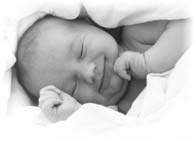Babies do the math on voices and faces at 7 months
Babies have a rudimentary grasp of maths long before they can walk or talk, according to new research.

By the age of seven months infants have an abstract sense of numbers and are able to match the number of voices they hear with the number of faces they see. The research could be useful in devising methods for teaching basic maths skills to the very young, say researchers in the US. The study is published in Proceedings of the National Academy of Sciences.
Adults can easily recognise the numerical equivalence between two objects they see and two sounds they hear. This is also the case for some animals, such as the monkey, but until now there has been conflicting evidence about the ability of very young babies to do this.
Kerry Jordan and Elizabeth Brannon of Duke University, Durham, North Carolina, played a video of two or three adult women strangers simultaneously saying the word "look" to babies aged seven months.
The videos were displayed on two monitors positioned side-by-side as the babies sat on a parent's lap. Audio tracks, synchronised with both videos, were played through a hidden speaker.
On average, the infants spent a significantly greater proportion of time looking at the display that matched the number of voices they heard to the number of faces they saw.
"Our results demonstrate that by seven months of age, infants can represent the equivalence between the number of voices they hear and the number of faces they see," the scientists wrote, reports BBC News.
According to Scientific American, other studies with infants had delivered ambiguous results. Babies trained to expect to see two objects when presented with two tones stared longer at results that violated this convention, such as two tones and then three objects. And although babies correctly matched up drumbeats and household objects in one study, efforts to duplicate the result failed. Jordan and Brannon argue that each of these studies was flawed, either because training might have skewed the response, the tasks were too difficult or the objects were irrelevant to a baby.
The two researchers found in their own study that babies spent more time looking at videos showing the same number of unfamiliar human female faces as those represented in a simultaneous soundtrack of "look" sounds. "As a result of our experiments, we conclude that the babies are showing an internal representation of 'two-ness' or 'three-ness' that is separate from the [sounds and sights] and, thus, reflects an abstract internal process," Brannon says.
O.Ch.
Subscribe to Pravda.Ru Telegram channel, Facebook, RSS!


